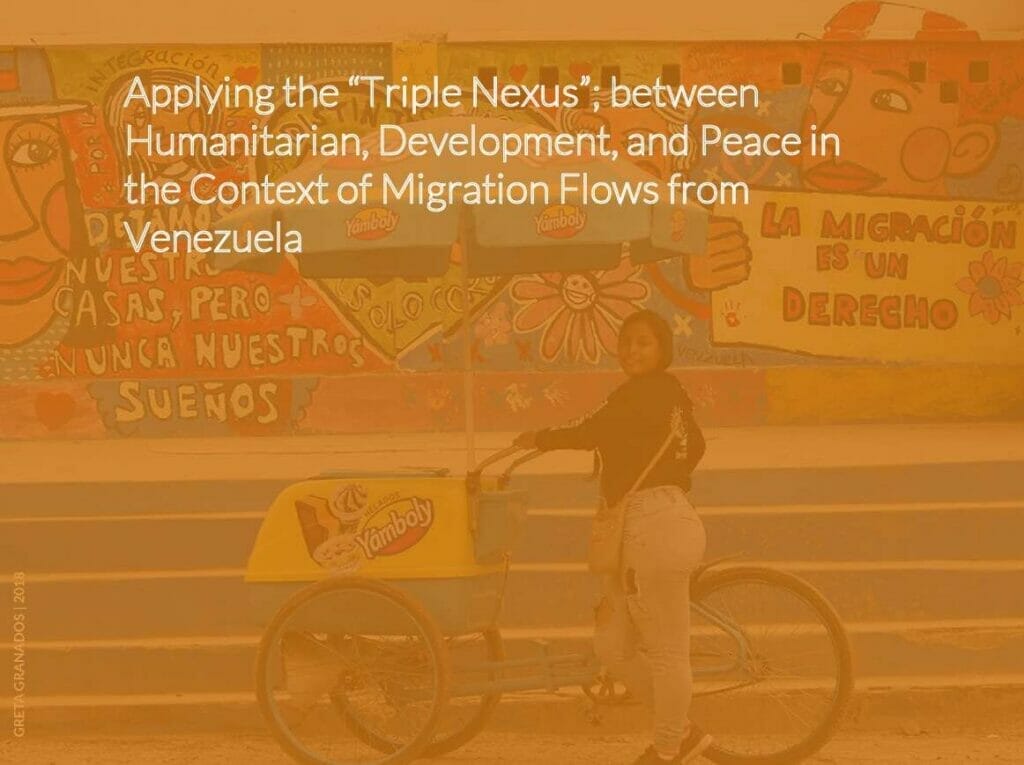
Since 2012, Venezuela has been immersed in a political, institutional, and economic crisis that has led to the large-scale migration of people from the country (the second largest mobility crisis in the world after Syria), all of this occurring against the backdrop of multiple and complex, regional mobility crises. Many people had and continue to find themselves in unsustainable situations, leading to the mass exodus. As of October 2021, the R4V estimates that around 5.9 million Venezuelans are living abroad, of which 4.8 million are in Latin America and the Caribbean (R4V, 2021).
The response to the Venezuelan migration crisis was at first quite disjointed at the regional and global levels. Not until 2018, the UN Secretary General, in view of the urgent need for a coordinated and regional response to the migration crisis, proposed the creation of the so-called Regional Interagency Coordination Platform (also known as Response to Venezuelans or R4V), led by the International Organization for Migration (IOM) and the United Nations High Commissioner for Refugees (UNHCR), to coordinate response efforts in 17 countries in Latin America and the Caribbean. With the aim of achieving coherence and consistency between a variety of different actors directly involved in the response, the R4V seeks to bypass institutional barriers to respond to the crisis more effectively. Yet there is a perception that the Venezuelan migration crisis will not end in the short or medium term, and the return of Venezuelans is currently not a realistic option. The main objective of this study, which addresses the challenge of applying the Humanitarian-Development-Peace (HDP) Nexus in the context of migration flows from Venezuela, is to analyse the conditions appropriate for a Nexus response, involving the perspectives of different actors directly engaged in the crisis. The results demonstrate that as the crisis continues, it is essential that any coordinated response addresses not only the immediate concerns facing Venezuelan migrants and host communities, but also plans for development actions with a long-term perspective to the integration and regularisation of migrants abroad, backed by flexible financial frameworks and a commitment for capacity sharing between international and local/national actors. Such coordination and complementarity of actions incorporates elements of the Triple Nexus and can approach the migrant crisis with solutions that have sustainable and durable outcomes involving migrant and host communities alike. The study concludes with specific recommendations that can improve the effectiveness of the medium and long-term responses to the migration crisis.
The study has been launched by WeWorld and the Institute of Studies on Conflicts and Humanitarian Action (IECAH) within the EU-funded project framework "Responding to forced displacement in Latin America through capacity building and certification on EU Aid Volunteers- INPLACE", whose objective is to enhance the response capacities of current and potential EUAV hosting organisations on the phenomenon of forced displacement in Latin America.
Spanish version below
La aplicación del enfoque de “triple nexo” entre la acción humanitaria, el desarrollo y la paz en el contexto de los flujos migratorios de Venezuela.
Desde 2012, Venezuela se encuentra sumergida en una crisis política, institucional y económica que ha derivado en una crisis migratoria a gran escala (la segunda crisis de movilidad más numerosa del mundo después de Siria), enmarcada en una compleja crisis de movilidad regional. Muchas personas se encuentran en una situación insostenible que ha llevado al éxodo masivo. A octubre de 2021, el R4V calcula que alrededor de 5,9 millones de venezolanos se encuentran viviendo en el exterior, de los que 4,8 millones se encuentran en América Latina y Caribe (R4V, 2021).
La respuesta inicial a la crisis migratoria venezolana fue bastante desarticulada a nivel regional y mundial. Fue a partir de abril 2018, el Secretario General de las Naciones Unidas, ante el reconocimiento de la necesidad urgente de dar una respuesta coordinada y regional a la crisis migratoria de Venezuela, propuso la creación de la así llamada Plataforma Regional de Coordinación Interagencial (también conocida como Respuesta a los Venezolanos o R4V) liderada por Organización Internacional de las Migraciones (OIM) y Alto Comisionado de Naciones Unidas para los Refugiados (ACNUR), para coordinar los esfuerzos de respuesta en 17 países de América Latina y el Caribe, con un enfoque particular en lograr coherencia y consistencia en toda la respuesta. La percepción general es que la crisis migratoria venezolana no se va a acabar en el corto o medio plazo y tampoco el retorno es una opción viable en el momento actual. Por esta razón, se vuelve necesario incorporar planes a mediano y largo plazo, como el triple nexo.
El objetivo principal de este estudio, que aborda el reto de la aplicación del enfoque de triple nexo entre la acción humanitaria, el desarrollo y la paz en el contexto de los flujos migratorios venezolanos, es analizar si este enfoque resulta relevante para el trabajo en esta crisis duradera. Asimismo, es importante conocer cuáles pueden ser las ventajas del trabajo con enfoque de nexo, así como las posibles limitaciones o inconvenientes a los que se enfrenta en esta crisis. Se aportan además ideas y recomendaciones para mejorar las respuestas de medio y largo plazo de las diversas organizaciones.
El estudio ha sido puesto en marcha por WeWorld y el Instituto de Estudios sobre Conflictos y Acción Humanitaria (IECAH) dentro del marco del proyecto financiado por la Unión Europea "INPLACE - Respuesta al desplazamiento forzado a través del refuerzo de capacidades y la certificación en EUAV/Responding to forced displacement in Latin America through capacity building and certification on EU Aid Volunteers- INPLACE", cuyo objetivo es mejorar las capacidades de respuesta de las organizaciones de acogida de Voluntarios de Ayuda de la UE (EUAV) sobre el fenómeno del desplazamiento forzado en América Latina.



